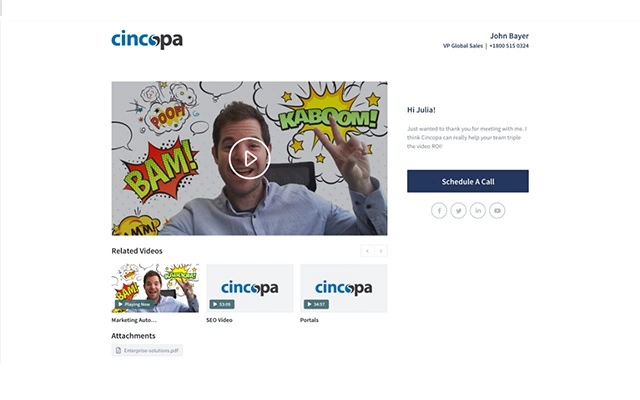Whether you have just started creating videos or have been doing video marketing for a while, coming up with a great video title is an important part of the process.
You can get everything else right; but, if your title isn’t compelling- you’re going to have a hard time getting people to click on the video.
On the other hand, a catchy video title will help you get more views and promote your video better.
Fortunately, writing video titles is a skill you can master with practice.
Here’s why video titles are important and how you can come up with a great one for your next video.
Why video titles matter
There is a lot of video content out there these days. Just think about it: YouTube is the largest search engine after Google, with 1.68 billion users worldwide. If you don’t find a way to get your videos in front of the right audience, they will probably get lost in the noise.
“If you have ever tried other types of content marketing, you know that a title or headline is often your only shot at getting someone’s attention. The same is true for video. “
A good title can help your video get found in the first place. While it’s not the main factor in video SEO, a strong title is a must if you want your viewers to find the video via search engines.
Which leads us to the next chapter…
How do video titles effect SEO?
Search engine optimization is not only important to written text. With the rise of visual content popularity on the web, it’s important to understand how to optimize all kinds of media for search engines.
Technically, search engines can’t really “watch” the video. Therefore, they rely on text-based data like titles, descriptions, and tags to understand the context.
Just to clarify, video titles are important but they aren’t everything. Other factors like video comments and view time also play a significant role in how high the video will rank.
A recent study by Backlinko revealed that on YouTube, videos get a small ranking boost if their titles contain an exact keyword match with the user’s search term.
In other words, if someone is searching for the term “homemade vegan pizza” and your video is titled “How to Prepare a Homemade Vegan Pizza”, you have a better chance of ranking higher than a video with the title “10 Italian Pizza Recipes You’ve Never Tried Before”.
Why doesn’t YouTube give exact keyword match in video titles more credit?
The reason might be that YouTube understands synonyms now, so it doesn’t rely on word-for-word matches as much anymore.
The bottom-line: Using exact word matches in your titles is a good idea, and it will help somewhat. But don’t expect it to transform your rankings overnight.
A good title can also help you rank outside YouTube. Now that Google is trying to offer its users the best result for their searches, many top results include videos, especially for how-to queries.
A good title can also help you rank outside YouTube. Now that Google is trying to offer its users the best result for their searches, many top results include videos, especially for how-to queries.
Most importantly, video titles effect your SEO by making your videos more (or less) user-friendly. At the end of the day, search engine optimization is not about tricking search engines to rank your videos higher. It’s about providing the best possible experience to users. A strong title does exactly that: It delivers value to your human audience, and that’s what search engines value the most.
The ingredients of a great video title
Need some inspiration for your next video title?
These tips will help you come up with catchy names for your videos. Just remember that there is no one-size-fits-all solution. So don’t be afraid to experiment and adjust your strategy.
5 tips for creating awesome video titles
1. Do your keyword research
Now that you know why keywords in video titles are important, how do you actually do your keyword research?
You can start with an online keyword finder tool. Luckily, there are some great free tools available in the market.
YouTube Suggest
Start with YouTube Suggest. It’s similar to Google Suggest, except it works for videos. Head over to YouTube and type in a search term. YouTube will show you other relevant results that people have searched for.
It makes sense to pay close attention to these phrases. Just think about it: YouTube is telling you the exact keywords that people search for.
Ubersuggest
Ubersuggest is one of my favorite SEO tools. You can type in a keyword, and the tool will show you the search volume (how many people search for the same term every month), keyword difficulty (how hard it’s going to be to rank for this keyword), and keyword ideas.
Keyword ideas from Ubersuggest
Although the tool is geared to work with Google search, it can still give you a solid idea of what key-phrases you can rank for.
YouTube Analytics
Finally, you can check your YouTube Analytics to find out what keywords you are currently ranking for. You can then better optimize your videos around this keyword.
To do that, in your YouTube account, head over to Analytics > Traffic source types and click on “YouTube search”.
This will open a list of keywords that your videos rank for. You can then check whether your videos are optimized for these keywords and better adjust the video titles accordingly.
Pro tip
An often-overlooked video keyword is the word “video” itself. If you’re focused on increasing your video’s visibility in non-YouTube search engines, it’s smart to include Video as a keyword at the end of your title.
2. Use a headline analyzer tool.
Once you start doing your keyword research, you will probably start coming up with some ideas for an actual video title. Use a headline analyzer tool to check how strong these ideas are. Here are some great options:
CoSchedule’s Headline Analyzer
Headline analyzers are great for giving you useful feedback on your ideas but take the results with a grain of salt. Artificial intelligence or algorithm will never be able to predict the emotional reaction of people to your video titles.
3. Keep it short
According to Brainshark, it’s best to keep your titles within 70 characters (including spaces).
Re-examine your video title. Can you get rid of a word or two without the title losing its zest? Go for it. Short and catchy video titles are more memorable and likely to be clicked on. Besides, they are less likely to get truncated in the search results.
4. Consider using a question format for your title
If you are working on a how-to or educational video that provides information or answers a question, consider putting this question in the video title. It also makes it easy to come up with video ideas. Research sites like Quora to find out what your audience might be looking for:
5. Be interesting
To come with an interesting video title, try answering these questions for yourself:
- Why should anyone care to watch the video?
- What’s in there for them?
- What will they miss if they don’t watch the video?
Here are some more concrete tips on coming up with an interesting video title:
- Create a fear of missing out: If you mention a secret or a special information that you are going to share in the video, people are more likely to watch it.
- Use a number or list: This way, people know what to expect from the video. Besides, everyone loves structured information.
- Offer expert tips: People value exclusive knowledge.
- Be sincere: Nobody likes clickbait video titles that don’t deliver what was promised. Remember: you are not trying to trick people into watching your video. Instead, you are trying to present it in the best possible way, to the right audience that will benefit the most from watching your video.
Conclusion
Coming up with compelling titles for your videos doesn’t have to be a daunting task. While it’s true that video titles play a significant role in your video promotion, creating them is not as difficult as one might think.
Wave.video is an online video maker that empowers everyone to create videos. With the built-in stock library of 300 million video + audio assets, 400+ ready-made video templates, and the free social calendar, Wave.video helps you create videos for your blog, social media channels, and website – in a snap.
















